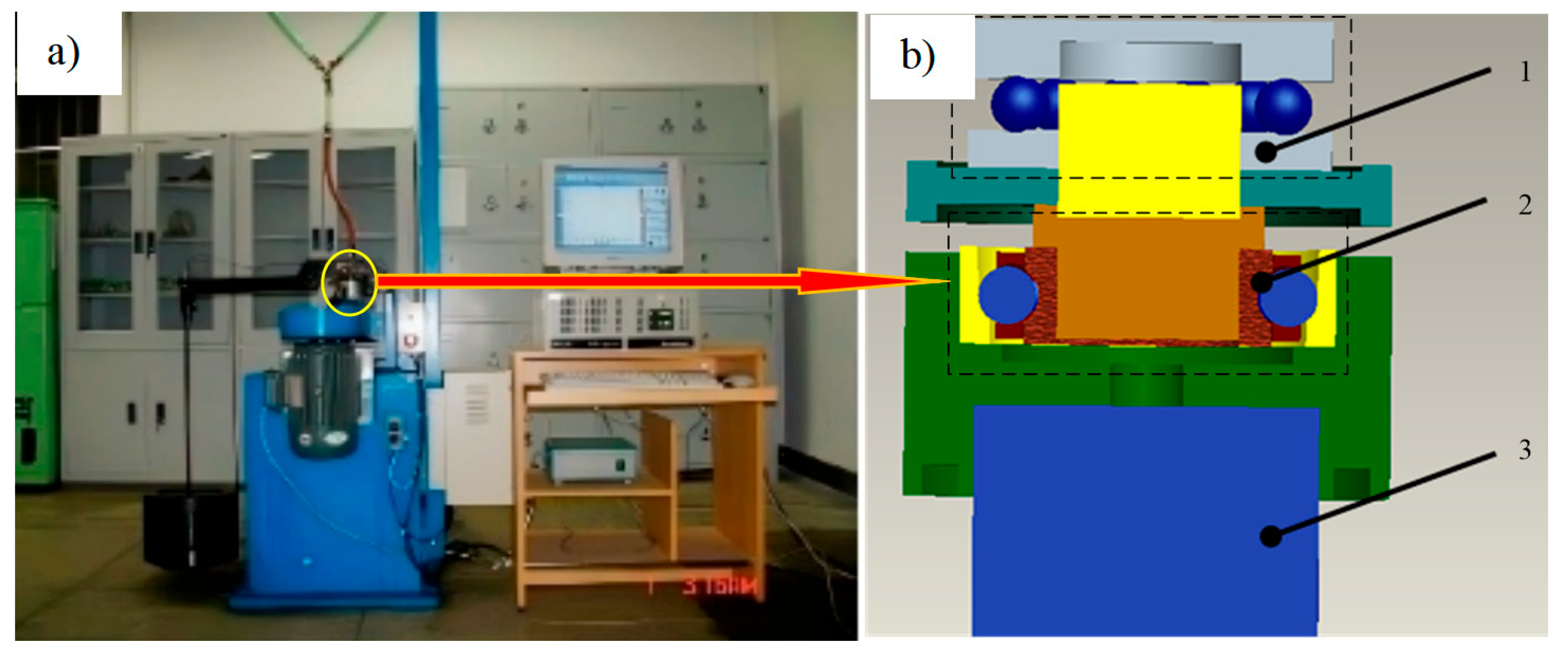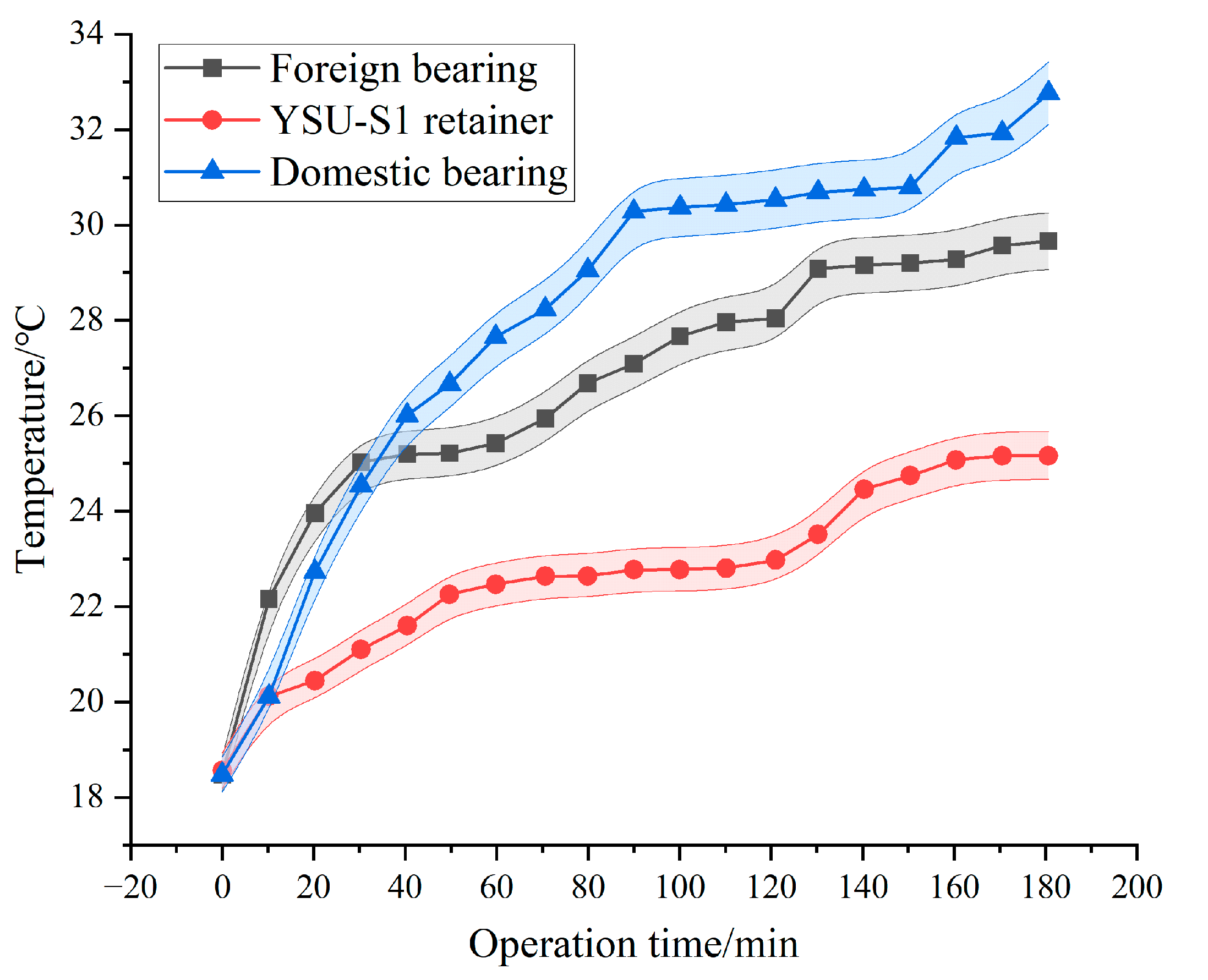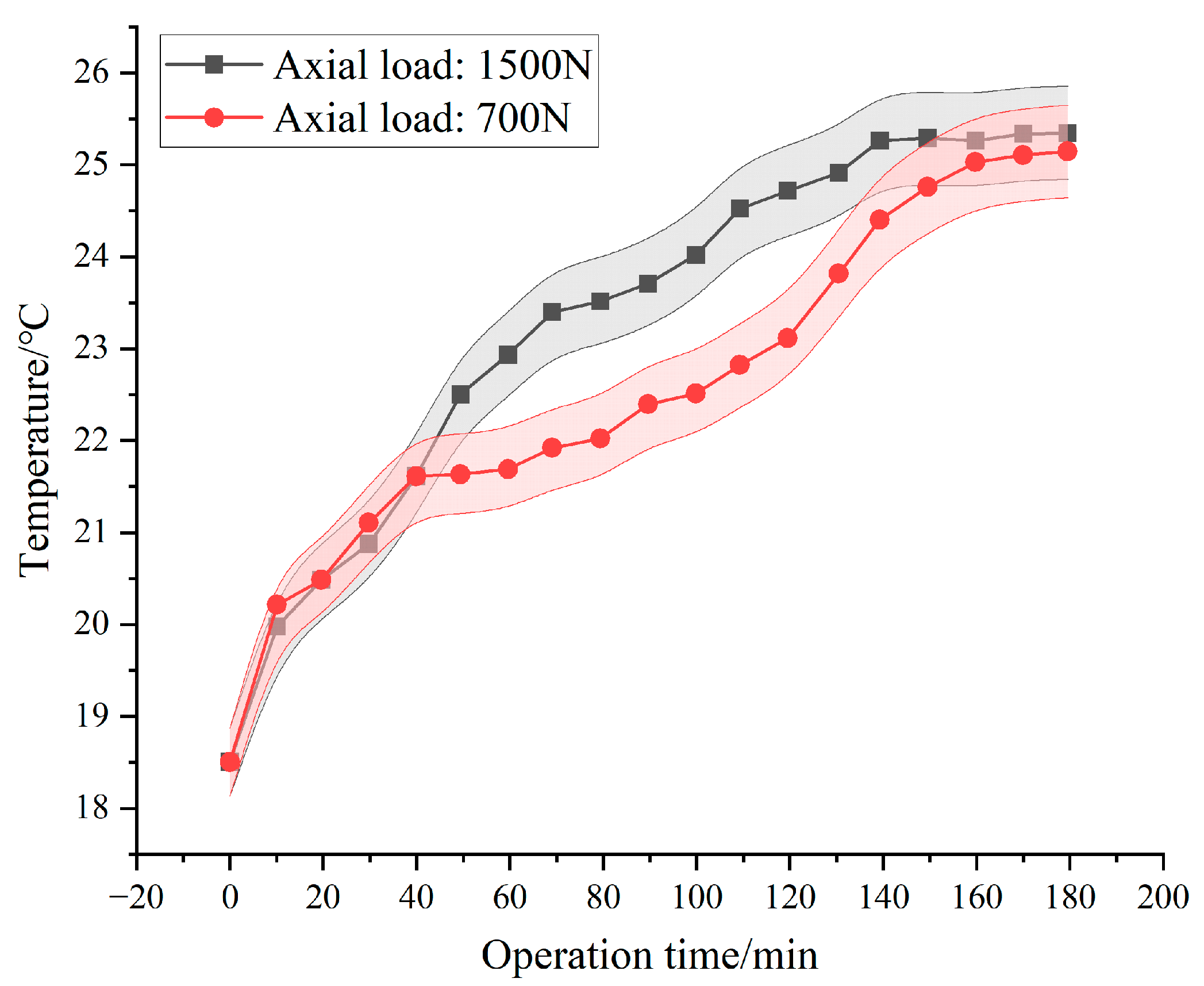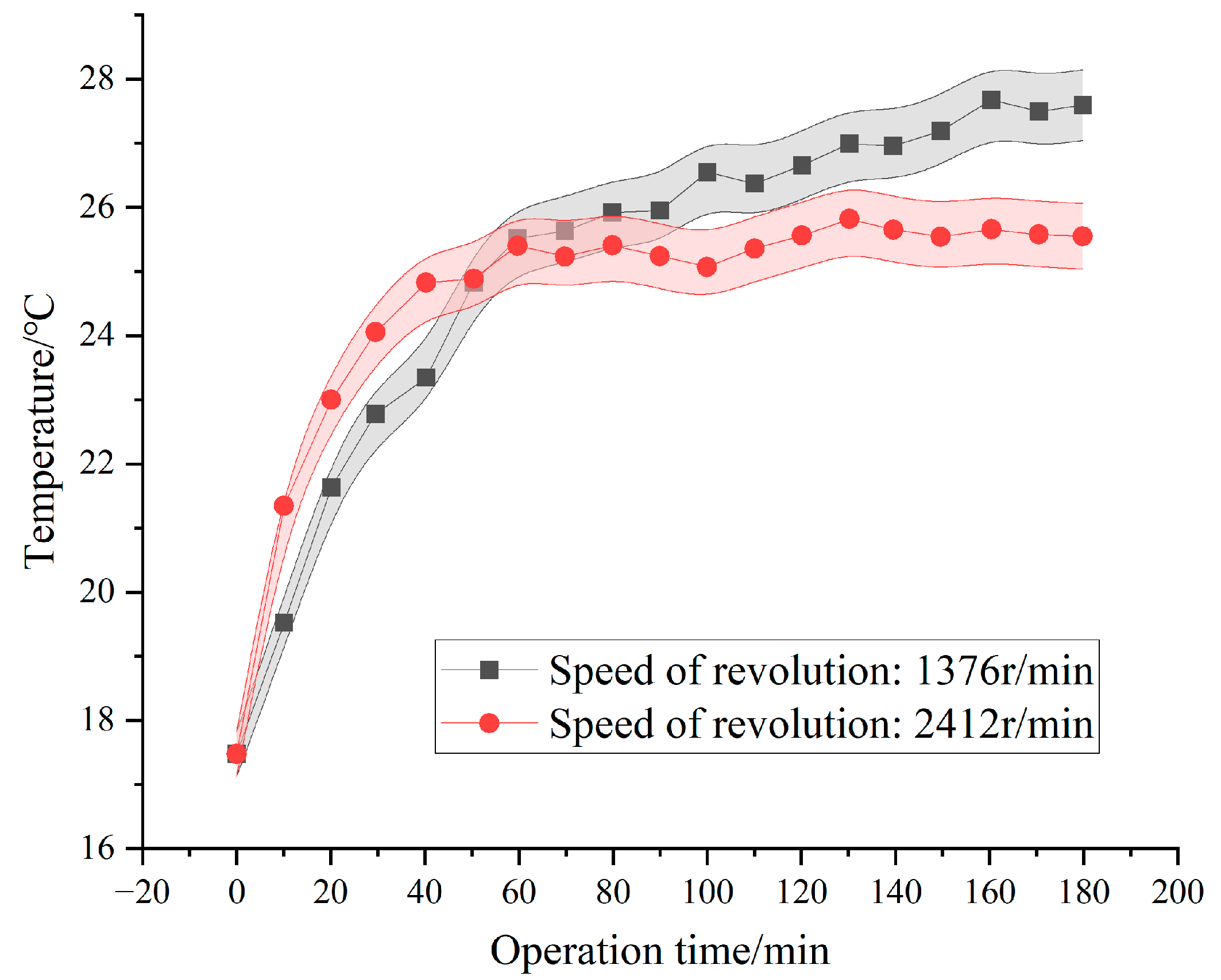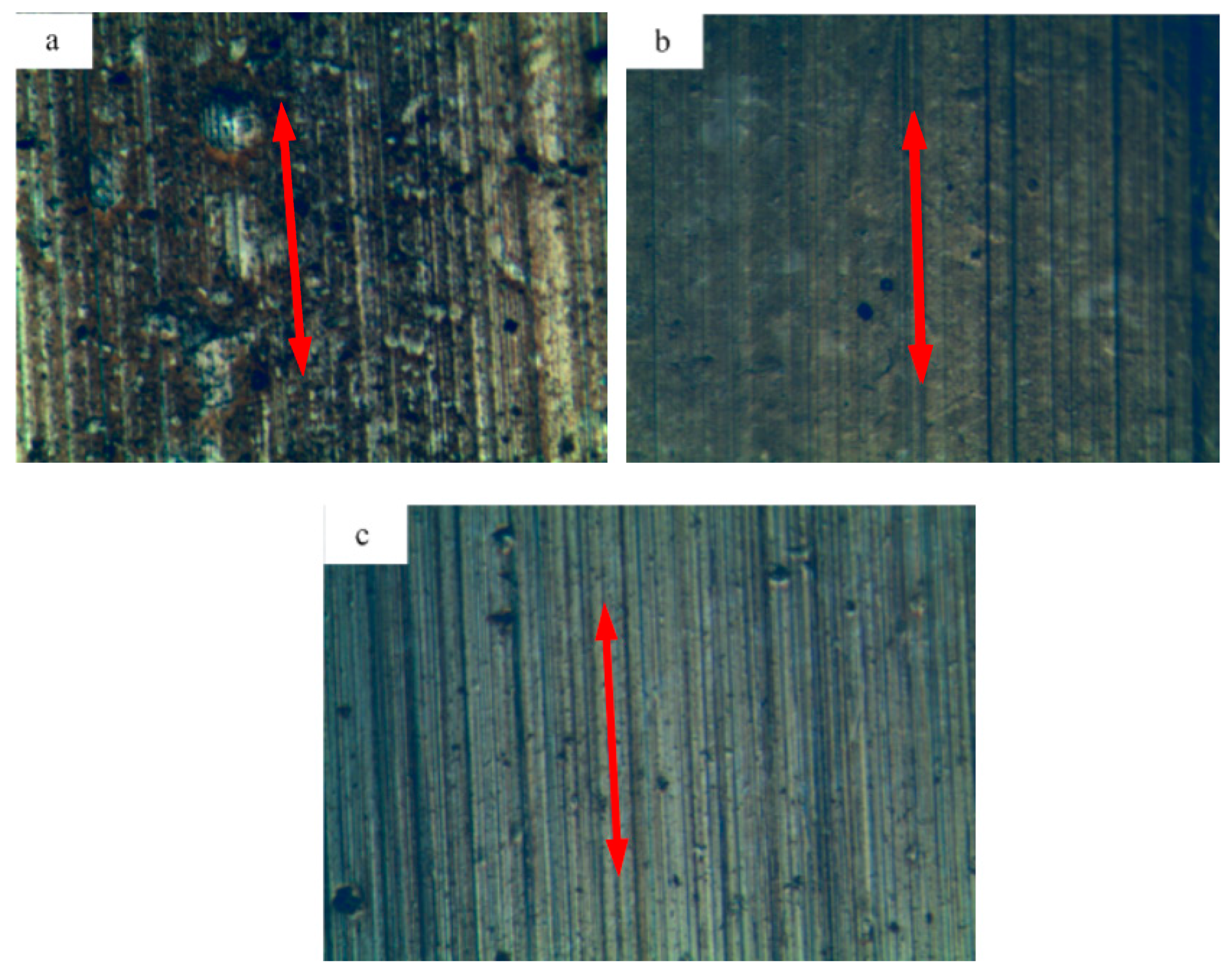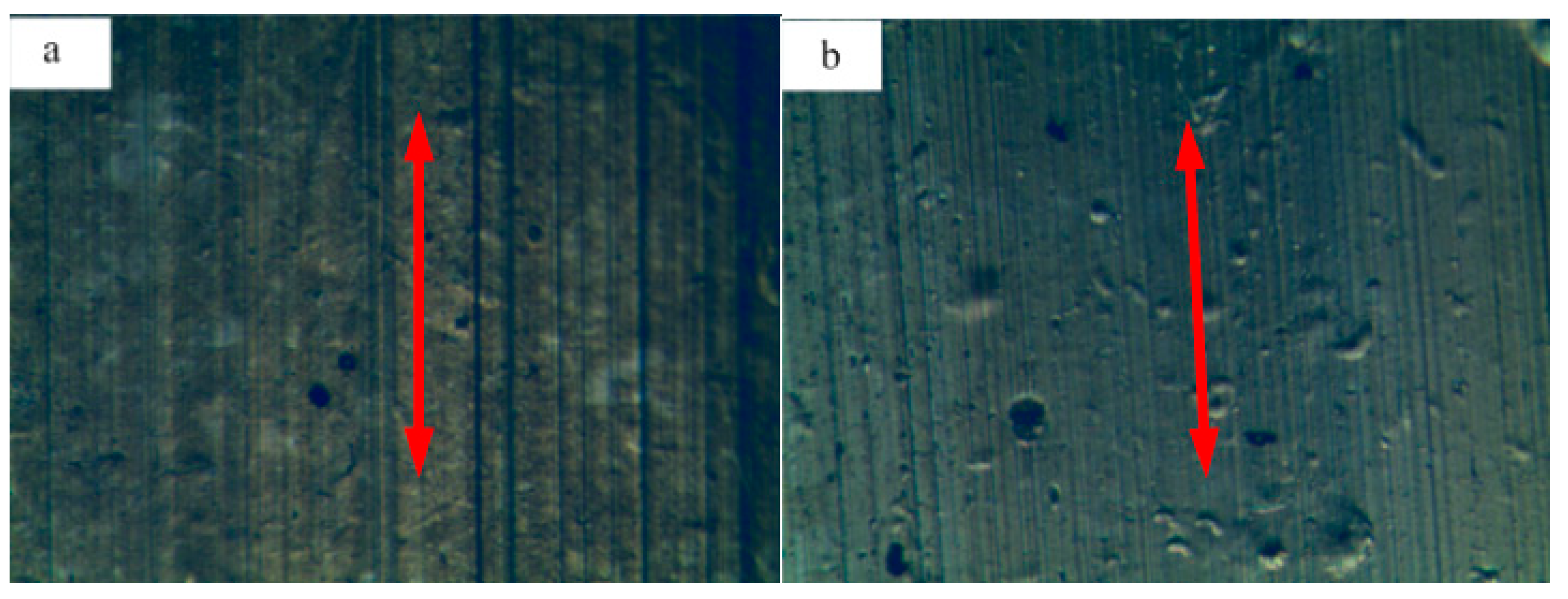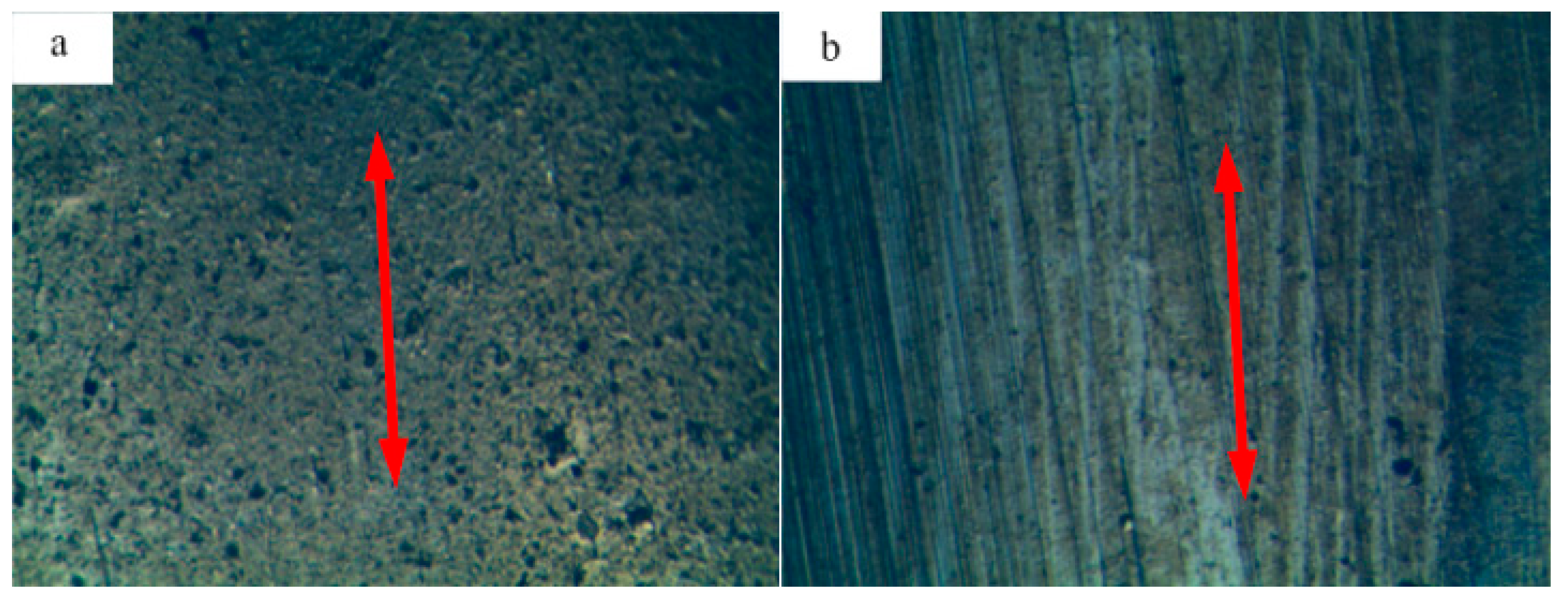1. Introduction
Rolling bearings play critical roles in aerospace and heavy machinery, where extreme conditions (e.g., oil starvation) demand materials balancing thermal stability and self-lubrication [
1]. Although advanced coatings [
2] and detailed optimization [
3,
4] enhance wear resistance at the component level, providing lubrication backup during temporary special operation remains a critical challenge at the system level [
5]. These potential practical needs have strengthened the research on advanced bearing solutions that can go beyond the limitations of traditional designs, especially for the response behavior under conditions of insufficient bearing lubrication in critical applications [
6,
7].
The tribological quintet of rolling bearings, comprising inner/outer rings, rolling elements, retainers, lubricants, and their complex interfacial interactions, forms a dynamically coupled system, where microscopic phenomena determine macroscopic performance [
8]. While substantial research efforts have focused on ring/raceway materials and surface engineering [
9,
10,
11], the retainer’s multifaceted role as a kinematic guide, load distributor, and potential secondary lubricant source has only recently gained systematic attention [
5,
12] Recent studies highlight retainers as “lubrication reservoirs” during oil starvation [
13], yet conventional designs (e.g., phenolic resins) suffer from thermal degradation above 150 °C [
14]. Polytetrafluoroethylene (PTFE)-based composites have strong potential applications due to their low friction and transfer film formation [
15], but little is known about their synergistic effect with bearing dynamics under high-load/speed combination conditions [
16]. Modern retainers must meet competing demands: minimizing friction-related power losses while maintaining structural sound under extreme stress [
17], guiding rolling element accurately without causing parasitic vibrations, and supplying backup lubrication during oil shortage [
18].
In recent years, significant progress has been made in bearing technology through three parallel innovation streams. Breakthroughs in surface engineering include nanostructured coatings such as Ti
3C
2T
x MXenes [
2] and composition graded W-DLC films [
19], which reduce the friction coefficient compared to traditional treatments [
20]. The advancement of materials science has produced high-performance ceramic hybrid materials [
21] and new bearing steels with nanocrystalline structures [
22], while polymer-based composite materials have become feasible alternatives for professional applications [
14]. However, these solutions mainly address component level challenges and often overlook system level interactions, especially the critical function of the retainer as a “conductor” of bearing dynamics [
23].
Lubrication challenges are most severe in aerospace applications, where conventional systems face intermittent starvation during high-G maneuvers [
1], cryogenic conditions in space environments [
24], or temporary oil system failures [
25]. These motion mechanisms require lubrication to ensure normal operation and performance throughout the entire task period [
26]. With the development of artificial intelligence (AI) technology, physics-based machine learning (PIML) has been applied in the field of tribology, achieving good predictive results [
27]. Self-lubricating retainers incorporating PTFE matrices with solid lubricant additives have demonstrated particular promise, maintaining low coefficient of friction even under serious conditions [
28], such as high loads, extreme temperatures, or dry rolling contact. When optimally formulated, these composites can form protective transfer films on raceways, creating a “self-healing” tribological interface [
15].
Despite these progress, important gaps remain in understanding how advanced retainers and bearing systems work together. The thermal–mechanical coupling effects under combined extreme conditions (high loads and velocities) remain poorly characterized [
16], while the kinetics of transfer film formation and its dependence on operational parameters lacks quantitative models [
29]. Recent molecular dynamics simulations suggest that nanoscale interfacial phenomena dominate retainer performance [
30,
31,
32], yet these insights have not been translated into practical design guidelines. Furthermore, the trade-offs between retainer flexibility and dynamic stability under variable loading conditions require systematic investigation [
31].
Although PTFE composites have advanced significantly, two fundamental issues still require solutions: (1) the load-speed threshold for effective transfer film formation, and (2) thermal–mechanical coupling effects on retainer integrity. This study bridges these critical knowledge gaps through a comprehensive experimental and analytical investigation of angular contact ball bearings equipped with novel PTFE-based composite retainers. Based on our foundational work in tribological composites [
33], we develop a material system specifically engineered for starved lubrication scenarios, incorporating two key innovations: (1) optimized solid lubricant synergy for enhanced transfer film formation, and (2) thermally stable hybrid reinforcement architecture, which establishes a novel process-structure–property–performance framework that connects micro-interactions with macro-bearing behavior.
This paper makes three primary contributions to the field: First, we present the first systematic characterization of temperature stabilization mechanisms in PTFE-based retainers across the complete operational envelope. Second, we elucidate the competing effects of load and speed on transfer film formation kinetics through surface analysis, which focuses on the tribological mechanisms of PTFE-based retainers in starved lubrication regimes. Finally, we derive practical implementation guidelines that balance performance metrics for specific application scenarios. These findings advance fundamental understanding while providing actionable insights for bearing designers facing lubrication reliability challenges.
2. Materials and Methods
2.1. Raw Materials
PTFE powder, with an average particle size of 500 mm, a density of 2.16 g/cm
3, and a tensile strength of 22–30 MPa, produced by Dongguan Xingwang Plastic Raw Materials Co., Ltd. (Dongguan, China); Nano La
2O
3, average particle size of 50 nm, Shanghai Acmec Biochemical Technology Co., Ltd. (Shanghai, China); Silicon Carbide whiskers, diameter 0.1–0.6 μm, length 50–100 μm, Qinhuangdao Yinuo High tech Materials Development Co., Ltd. (Qinhuangdao, China). Nano Al
2O
3, particle size of 30–60 nm, Hubei Huifu Nanomaterial Co., Ltd. (Yichang, China); Expanded graphite is prepared by chemical intercalation method, resulting in a layer thickness of less than 50 nm [
34]; Nano serpentine, self-made, prepared using the 8000D-230 high-energy ball mill produced by SPEX Sample Prep in the United States [
15].
2.2. Self-Lubricating Retainer Preparations
Polytetrafluoroethylene (PTFE) and its composites are made using a method similar to powder metallurgy. This process combines cold pressing and sintering molding techniques. Cold pressing involves key parameters: pressure, which controls material density and uniformity; time, which ensures proper deformation while avoiding excess stress; pressing rate, which affects material flow and final structure strength. Sintering includes these critical steps: heating rate, which must be balanced to reduce thermal stress and ensure even heat; sintering temperature, which is key for strong particle bonding and lower porosity; holding time, allowing for material fully diffusion and bond; cooling rate: affecting residual stress levels and final microstructure.
Figure 1 illustrates the complete manufacturing sequence from raw material preparation through solidification. Additional processing details, including heat treatment methodologies to enhance mechanical properties or optimize tribological performance under various operating conditions can be found in our previous investigations [
33,
34]. These studies provide comprehensive experimental datasets and analyses, offering complete characterization of PTFE composite fabrication processes, material behavior under different processing conditions.
2.3. Rolling Bearing Tests
The fatigue testing apparatus is specifically designed to assess the rolling contact fatigue (RCF) performance in angular contact ball bearings. This sophisticated system integrates multiple subsystems that collectively ensure precise and reproducible test conditions. The primary subsystems include a mechanical transmission system, control and measurement instrumentation, and lubrication, cooling provisions, and computerized control infrastructure. Each subsystem contributes critically to the overall operational integrity and testing accuracy of the apparatus.
Figure 2 presents the schematic diagram of the mechanical transmission system for 7206C angular contact ball bearing testing. The on-site photo of the rolling contact fatigue testing machine is shown in
Figure 3a, and
Figure 3b is a schematic diagram of the installation of the tested bearing. The loading mechanism employs a lever amplification system to apply force to thrust ball bearing assembly (Component 1), which subsequently transfers the load to the test specimen (angular contact ball bearing, Component 2). During operation, the bearing’s inner ring remains stationary while the outer ring and rolling elements rotate at high velocity. This kinematic arrangement induces relative sliding between the rolling elements and retainer, driven by the outer ring’s motion and control. The system achieves variable rotational speeds through frequency converter-based stepless speed regulation, and the temperature is measured on the outer surface of the bearing using a handheld infrared thermometer.
2.4. Experimental Details
The tested angular contact ball bearing model is 7206C, and its parameters are as follows: inner diameter 30 mm, outer diameter 62 mm, width 16 mm. The custom-designed retainers, fabricated from PTFE-based composites, maintained identical dimensional parameters to the original retainers.
Prior to testing, all bearings underwent standardized pretreatment procedures: (1) oil immersion at 100 ± 2 °C for 45 min, (2) comprehensive cleaning of inner/outer rings and raceways, and (3) meticulous removal of residual oil from retainer surfaces to quickly evaluate the operational performance of the bearing system under oil-depleted conditions. To ensure the accuracy and reliability of the data, each experiment under different conditions was repeated three times.
3. Results and Discussion
3.1. Comparative Performance Analysis
Temperature rise characteristics serve as a vital performance indicator that reflects the comprehensive operational status of bearings during service. Continuous temperature monitoring is therefore essential for maintaining proper bearing function. Following operational termination, each bearing was disassembled to examine wear patterns on all components. This thorough inspection provides critical data for comprehensive performance evaluation, ensuring reliable and accurate bearing assessment.
Figure 4 presents the temperature–time profiles for three bearing configurations under identical operating conditions (1376 r/min rotational speed, 700 N axial load, 3 h test duration): (1) a domestic bearing, (2) an imported NSK bearing (NSK Ltd., Tokyo, Japan, with Phenolic resin retainer), and (3) YSU-S1 bearing (a custom-designed bearing model developed for this study) featuring a PTFE-5% Serpentine-5% Silicon Carbide whisker (SiCw) composite retainer. The results demonstrate that the YSU-S1 bearing exhibited significantly lower temperature rise compared to both the domestic and NSK bearings. This enhanced thermal performance suggests superior operational efficiency and durability of the YSU-S1 design. The observed behavior can be attributed to the progressive formation of a self-lubricating transfer film. This beneficial tribological layer develops through dynamic interactions between the composite retainer material and rolling elements, as well as the rolling elements and the bearing’s inner/outer rings. The established transfer film effectively reduces friction [
26] and associated heat generation, explaining the YSU-S1 bearing’s improved thermal characteristics.
The experimental results reveal distinct thermal response patterns among the three bearing configurations during the initial operational phase (0–30 min in
Figure 4). The foreign-manufactured bearing displays the most substantial temperature elevation, followed by the domestic bearing. Notably, the YSU-S1 retainer-equipped bearing demonstrates a markedly lower temperature rise, with a maximum temperature reduction of approximately 60% compared to the foreign bearing. This significant thermal performance enhancement directly correlates with the advanced tribological characteristics of the PTFE-based composite retainer material. The hybrid self-lubricating materials effectively reduce interfacial friction, thereby minimizing heat generation at contact surfaces. In whole, both short-term (0–30 min) and long-term (30–180 min) operational data confirm that the YSU-S1 bearing maintains optimal thermal characteristics, as evidenced by its consistently lower temperature gradient throughout testing.
To quantitatively evaluate the implications of thermal management improvements, we performed a linear extrapolation of temperature–time profiles using 40 °C as a critical reference threshold (selected based on industry standards for accelerated wear testing). The analysis reveals that the YSU-S1 bearing exhibits a 2.37× lifespan extension compared to domestic bearings and a 1.83× improvement over foreign bearings. This performance advantage stems from the YSU-S1’s optimized friction interface design and self-lubricating materials, which effectively suppress temperature rise and delay fatigue/wear progression in critical components. Notably, these estimates are derived under steady-state load conditions—factors such as dynamic loading, lubrication variability, and environmental contaminants in real-world applications may modulate the actual lifespan ratios. Nevertheless, this analysis provides critical data supporting the YSU-S1’s enhanced reliability in industrial settings, demonstrating its potential to bridge the gap between thermal efficiency and operational durability.
3.2. Load Impact Evaluation
The thermal characteristics of YSU-S1 bearings incorporating self-lubricating retainers were evaluated under constant rotational speed (1376 r/min) with varying axial loads (700 N and 1500 N), as shown in
Figure 5. Analysis of the temperature rise curves reveals a load-dependent thermal response, wherein increased axial load results in elevated bearing temperatures.
At the higher load (1500 N), the bearing temperature shows a consistent rise with operating time, aligning with classical tribological principles. Increased axial force intensifies interfacial shear stresses and micro-slip at rolling element/raceway contacts, consequently elevating frictional heat generation. In contrast, the 700 N condition demonstrates an initial temperature decline followed by a gradual ascent. This transient behavior may be attributed to the lower load and improved anti-friction properties allow the generated heat to radiate more quickly to the external space, temporarily offsetting frictional heating until thermal equilibrium occurs.
Remarkably, despite these differing transient responses, the overall thermal variation between the two loading conditions remains small, with a maximum observed temperature differential of <2 °C (40~140 min in
Figure 5). The narrow variation highlights the self-stabilizing thermal–mechanical behavior of the YSU-S1 system, achieved through two key mechanisms: The embedded solid lubricants (PTFE/ serpentine) in the retainer provide continuous lubrication replenishment at rolling element-guide interfaces, effectively suppressing friction-induced temperature surges. Under operational loads, the retainer acts as an intermediate component in frictional contact with the rolling elements, promoting the in situ formation of a self-lubricating tribofilm. Concurrently, the rolling elements transfer this lubricating film to the bearing raceways, significantly enhancing the system’s anti-friction characteristics. This mechanism leads to the complexity of tribology (micro-bearing effects, rolling/sliding contact, particulate dynamics), resulting in a significant decrease in friction coefficient, which is a self regulating mechanism that limits thermal runaway.
Ultimately, the bearing temperature stabilizes near 25 °C, indicating a dynamic equilibrium between frictional heating and conductive/convective cooling. This stability is facilitated by the retainer’s dual role: the self-lubricating material minimizes mixed friction, consequently reducing interfacial stress and friction heat generation at contact zones; continuous lubricant replenishment maintains stable interfacial conditions, promoting uniform heat distribution throughout bearing components.
3.3. Speed Effect Investigation
Figure 6 shows the temperature behavior of YSU-S2 bearings with PTFE-10% expanded graphite (Nano EG)-10% Al
2O
3 composite retainers under different speeds (1376 and 2412 r/min) at a constant load (700 N). At 1376 r/min, the temperature keeps increasing throughout the test, reaching 28 °C without stabilizing, suggesting insufficient lubricating film formation. At 2412 r/min, the temperature stabilizes after the initial rise, maintaining a lower peak temperature (26 °C) with little variation. Notably, the high-speed operation consistently shows lower temperatures than low-speed operation, indicating better thermal stability.
This occurs because higher speeds promote better lubricating film formation. Faster rotation speeds help transfer self-lubricating materials more effectively, depositing PTFE and graphite in contact areas to form a protective film. At the same time, Al
2O
3 nanoparticles reduce wear, and graphite’s layered structure enables easy sliding, both helping to lower friction. The resultant self-regulating mechanism, where higher speeds improve lubrication rather than generate excessive heat-explains the inverse speed-temperature relationship. This behavior highlights the composite retainer’s ability to optimize friction and heat dissipation dynamically, making it particularly suitable for high-speed applications, where thermal management is critical [
35,
36,
37].
An interesting experimental observation shows that within the first 50 min, the temperature of the bearings at higher speeds increases slightly higher than at lower speeds. This phenomenon suggests that the formation of the lubricating film is not merely a time-dependent process, but also exhibits significant speed dependence. The initially formed mixed lubricating film composed of PTFE and graphite exhibits greater sensitivity to mechanical forces under high-speed conditions. The presence of this discontinuous lubrication transfer film leads to an increase in frictional power consumption, resulting in a faster temperature rise.
3.4. Wear Mechanism Interpretation
Figure 7 presents a comparison of wear patterns on outer ring raceways from three distinct bearing types examined under optical microscopy: domestically produced bearings, an imported NSK bearing, and a bearing equipped with the YSU-S1 self-lubricating retainer. All tests used the same conditions (1376 r/min speed, 700 N load, 100 °C oil pretreatment, 3 h duration) to better elucidate the bearings’ inherent wear properties. The arrow in the figure indicates the direction of linear velocity.
Figure 7a reveals significant wear on domestic bearings, showing clear pitting and surface erosion. These defects indicate that the bearings experience relatively severe friction and wear during operation. By contrast,
Figure 7b shows the YSU-S1 bearing’s much smoother raceway surface.
It is worth noting that the self-lubricating film forms primarily along the Hertzian contact zone between rolling elements and raceway, which acts as a protective barrier, reducing friction and wear. The NSK bearing (
Figure 7c) shows moderate wear, more than YSU-S1 but less than domestic bearings. Specifically, the wear surface displays a small number of micro-peeling pits, indicating moderate wear. In addition, compared with other two bearings, the wear traces of YSU-S1 bearing raceway are narrower and shallower, indicating that lubrication and wear resistance have been improved.
The differences in wear patterns can be attributed to several factors, including the composition and performance of the bearing material, the design of the retainer, and the effectiveness of self-lubricating. For YSU-S1 bearings, customized self-lubricating retainers may help form a protective lubricating film, reducing friction and wear. In contrast, domestically produced bearings may lack these features, leading to severe wear and damage. NSK bearings, as an imported product, may benefit from advanced manufacturing technology and materials properties, thereby improving wear resistance and lubrication performance.
Figure 8 clearly shows how the outer race surface wears differently for YSU-S1-type bearings under two load conditions (700 N and 1500 N) at a constant speed of 1376 r/min. The arrow indicates the sliding direction of the rolling elements. At the lower load (700 N
Figure 8a), the wear tracks on the contact surface are relatively small and narrow. This indicates that under lighter loads, the wear process is less severe, resulting in only slight material removal. The wear patterns are confined to localized areas, which suggests effective lubrication film performance in reducing friction and wear. Conversely, under higher loading (1500 N
Figure 8b), which represents higher working loads (1500 N), the bearing surfaces exhibit pronounced wear damage characterized by three progressive stages of deterioration. First, increased contact stresses at the rolling element/raceway interface accelerate crack initiation and propagation within the near-surface material. These subsurface cracks then migrate toward the surface, manifesting as visible peeling pits across the worn contact area. Ultimately, the coalescence of these cracks leads to material removal through spalling, the detachment of surface patches ranging from several micrometers to hundreds of micrometers in size. This spalling mechanism represents the final stage in a cascade of tribological failure processes initiated by excessive contact stresses under high loading conditions.
The transition from slight wear under lower loads to more severe wear under higher loads is attributed to multiple mechanistic factors. Primarily, elevated contact pressure induced by increased loading exacerbates wear mechanisms. Concurrently, the diminished lubricating film efficacy arises from heightened frictional forces under greater loads. fatigue wear progression is accelerated by cyclical stress patterns inherent in equidistant rolling element configurations during repeated high-load operations.
Figure 9 comparatively analyzes wear morphologies on outer raceways of YSU-S2 bearings equipped with self-lubricating retainers under 700 N axial load at differential rotational velocities: 1376 r/min (
Figure 9a) and 2412 r/min (
Figure 9b), with directional arrows denoting rolling element trajectories. Both cases demonstrate sustained formation of self-lubricating surface films across tested velocities. Nevertheless, detailed analysis reveals distinct speed-dependent morphological divergences.
At 1376 r/min (
Figure 9a), the raceway exhibits coarse textural features with sparse shallow abrasions, indicative of wear processes predominantly governed by gentler interfacial interactions. Reduced frictional energy under lower velocities restricts lubricant transfer efficacy, resulting in discontinuous thin-film lubrication. Conversely, at 2412 r/min (
Figure 9b), enhanced surface regularity with fine unidirectional striations emerges. Elevated kinematic energy promotes intensified frictional heating, thereby optimizing lubricant redistribution to establish a coherent thick-film barrier that substantially mitigates wear progression.
These morphological distinctions originate from tribochemical dynamics occurring at the contact interface. Augmented mechanical energy at higher velocities catalyzes tribofilm formation—a protective composite layer synthesized through mechanochemical reactions between lubricant constituents and bearing substrates [
38,
39]. This tribologically transformed surface functions as a sacrificial barrier, effectively minimizing metallic adhesion while enhancing lubrication efficiency. The self-lubricating retainer mechanism demonstrates particular efficacy through continuous lubricant replenishment to raceway interfaces, establishing low-friction boundary layers that concurrently reduce frictional coefficients, thermal generation, and associated performance degradation.
Although this study demonstrates the efficacy of PTFE-based retainers under controlled oil-starvation conditions, several limitations must be acknowledged. The experimental scope is confined to specific bearing models (7206C) and discrete operational parameters (load/speed). Addressing these constraints, further validation under dynamic loading, extended durations, and contaminated environments remains essential prior to industrial implementation. Nevertheless, these results establish a foundational framework for optimizing self-lubricating bearing design, particularly in starvation-prone applications.


